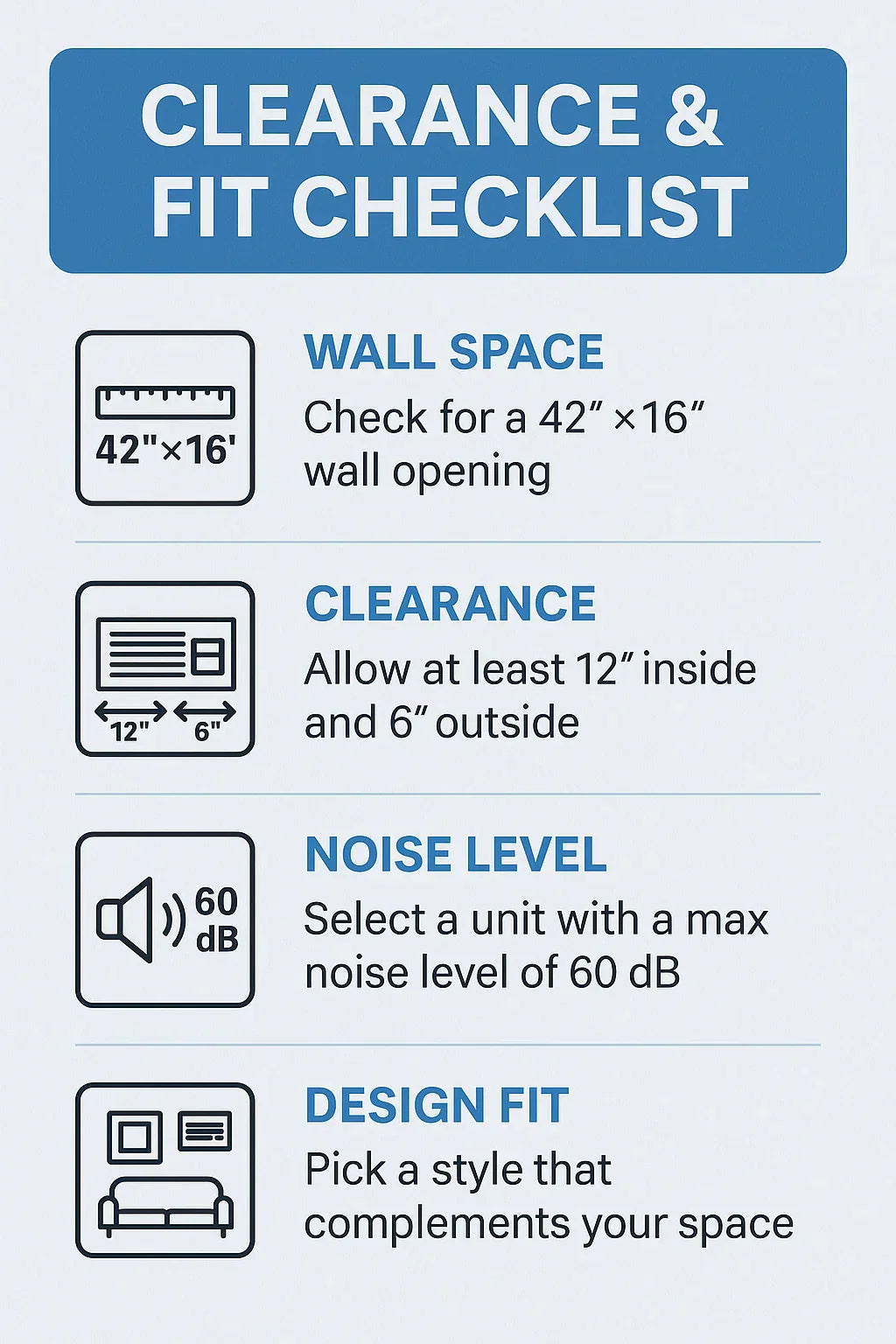Choosing a new wall-mounted heating and cooling unit isn’t just about price or efficiency—it’s about whether the system will actually work in your space. The wrong choice could mean a noisy bedroom, an oversized unit blasting cold air into a small den, or a design that clashes with your living room’s aesthetic.
If you’re comparing Amana, GE, and Hotpoint units, this guide will help you figure out how each brand fits into your home’s layout, noise comfort level, and design expectations.
🔊 Noise Levels: How Loud Are These Units?
Noise is one of the top homeowner complaints about wall and PTAC units. Measured in decibels (dB), the sound rating tells you how loud a unit will be at full operation.
-
Amana
-
Typically operates between 50–60 dB.
-
Comparable to a normal conversation.
-
Quiet enough for living rooms, but in bedrooms, light sleepers may notice.
-
-
GE
-
Known for quieter operation—some units rated as low as 45–55 dB.
-
Often used in hotels because of noise control.
-
Ideal for bedrooms or offices.
-
-
Hotpoint
-
Slightly louder on average, 55–65 dB.
-
Works well in kitchens or dens, but might be noticeable in bedrooms.
-
👉 The EPA noise guide states that most people prefer under 55 dB indoors for comfort.
💡 Takeaway: If noise is a dealbreaker, GE is your best bet.
📏 Space & Clearance Requirements
Every unit needs enough space around it to work properly. If you try to wedge one into a too-small opening, you’ll get poor airflow and higher energy costs.
-
Wall Sleeve Dimensions
-
Standard size: 42" wide x 16" tall (fits most Amana & GE).
-
Hotpoint often uses slightly smaller sleeves for compact units.
-
-
Clearance Inside
-
Leave 12–18 inches of clearance in front for airflow.
-
Avoid blocking with furniture.
-
-
Clearance Outside
-
At least 24 inches of space behind the exterior grille.
-
No shrubs, fences, or decks blocking airflow.
-
👉 See EnergyStar installation guidelines for clearance recommendations.
💡 Pro Tip: Amana’s heavy-duty sleeves are great for retrofits, while GE’s sleeves are designed for hotel and condo standards.
🎨 Design Aesthetics: Will It Look Good in Your Space?
Beyond performance, you want a unit that blends into your room.
-
Amana
-
Rugged, functional design.
-
More utility-focused, but looks fine in dens or rental properties.
-
Color options limited to neutral white or beige.
-
-
GE
-
Sleeker designs with modern grills.
-
Blends better in contemporary homes and condos.
-
Options for smart thermostat integration = less clutter.
-
-
Hotpoint
-
Basic, no-frills design.
-
Great for budget remodels, rentals, or basements.
-
Less focus on style, more on affordability.
-
👉 Check out GE Appliances – Zoneline PTAC for a look at modern finishes.
💡 Takeaway: For style-sensitive spaces, GE wins again.
📊 Room Size & BTU Matching
No matter the brand, getting the right BTU size matters more than anything else.
-
Too Small → The unit won’t cool or heat effectively.
-
Too Large → It will short-cycle, causing higher bills and uneven comfort.
BTU Guidelines (per EnergyStar):
| Room Size | Recommended BTUs |
|---|---|
| 150–350 sq. ft. | 5,000–8,000 BTU |
| 350–550 sq. ft. | 8,000–12,000 BTU |
| 550–1,000 sq. ft. | 12,000–18,000 BTU |
| 1,000–1,500 sq. ft. | 18,000–24,000 BTU |
👉 Use EnergyStar’s room size to BTU calculator to confirm your match.
💡 Pro Tip: Amana and GE both offer wide BTU ranges. Hotpoint focuses on small-to-mid spaces.
🛋️ Brand-by-Brand Fit
🔴 Amana
-
Best for durability and rentals.
-
Fits standard 42" sleeves.
-
Noise moderate; style basic.
🔵 GE
-
Best for quiet bedrooms, condos, or hotels.
-
Sleekest design and strongest EnergyStar compliance.
-
Great balance of style + performance.
⚪ Hotpoint
-
Best for budget spaces like garages, basements, or small apartments.
-
Slightly louder, simpler design.
-
Compact options for tight spaces.
🤫 Tips for Quiet Comfort
No matter which brand you choose, here’s how to maximize comfort:
-
Choose the right size → Oversized units are noisier.
-
Check the decibel rating → Anything under 55 dB is comfortable.
-
Add sound insulation → Install foam strips around the sleeve.
-
Place smartly → Don’t install directly above a bed or couch.
👉 The DOE’s AC maintenance tips also cover noise prevention through upkeep.
📊 Fit & Design Comparison Chart
| Feature | Amana | GE | Hotpoint |
|---|---|---|---|
| Noise Level | Moderate (50–60 dB) | Low (45–55 dB) | Higher (55–65 dB) |
| Clearance Needs | Standard | Standard | Compact options |
| Design Style | Functional | Modern/Sleek | Basic |
| Best Use Case | Rentals, dens | Bedrooms, condos | Budget remodels |
📝 Samantha’s Final Thoughts
When I first considered a wall unit, I thought only about price. But after living with one in my bedroom, I realized noise and fit mattered even more.
-
If you want quiet + modern design, GE is your best option.
-
If you want long-lasting reliability, Amana will serve you well.
-
If you just need a cheap and functional solution, Hotpoint works.
Bottom line? Take time to measure, check decibels, and think about where the unit will sit. Comfort isn’t just about cooling—it’s about how well the unit fits your lifestyle.
In the next topic we will know more about: Troubleshooting Guide: What to Do If Your Amana, GE or Hotpoint Unit Isn’t Heating or Cooling







